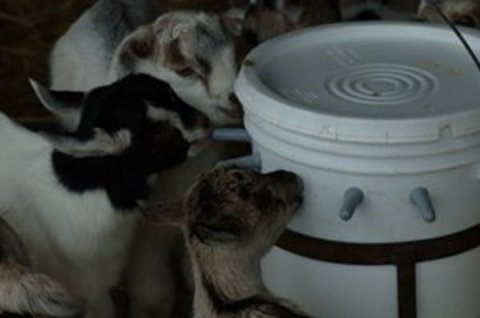Annie shows a baby how to feed
Valentine’s Day saw the birth of our first baby goat of 2010. The babies are an irresistible mix of soft chocolate and mushroom browns, white and black, and a delight to watch snoozing on their straw or leggily staggering after one another. Perhaps a third of mothers need a little help with birthing, an extra hand to gently tug the babies out. We always have the liveliest older babies in Tony’s Pen at weekends, so do come and admire them close up.
Like all other best-practice dairies, we separate the babies from their mothers shortly after birth, to make sure each kid is fed well. The mothers have between one and four babies, and will usually feed the strongest more than the rest. We bottle-feed each baby goat fresh, pasteurized goat milk, and formula enhanced with vitamins and minerals, for about six to eight weeks, until they’re all at optimum weight.
We can’t help but feel regretful at taking babies from mothers, but must follow veterinary guidelines for dairy herds, to ensure best possible health for every goat. This way, too, we limit the spread of complications that can show up in later life. For example, older goats may get arthritis as a result of infections received shortly after birth if left with their mother.
At two weeks of age, we vaccinate, dehorn and tattoo the babies with their identifying code. We use the American Dairy Goat Association code, to let us know the kid’s mother and father. The babies will live in "Baby Goatland", separated by similar age and size into little fenced groups of six to seven goats. The larger, more dominant babies won’t bully the weaker ones, this way, producing a more successfully social herd.
Since we’re expecting more than 200 babies, this is a lot of work! We have a cot in the barn, and some sleepless nights ahead.

Most babies get the idea straightaway
